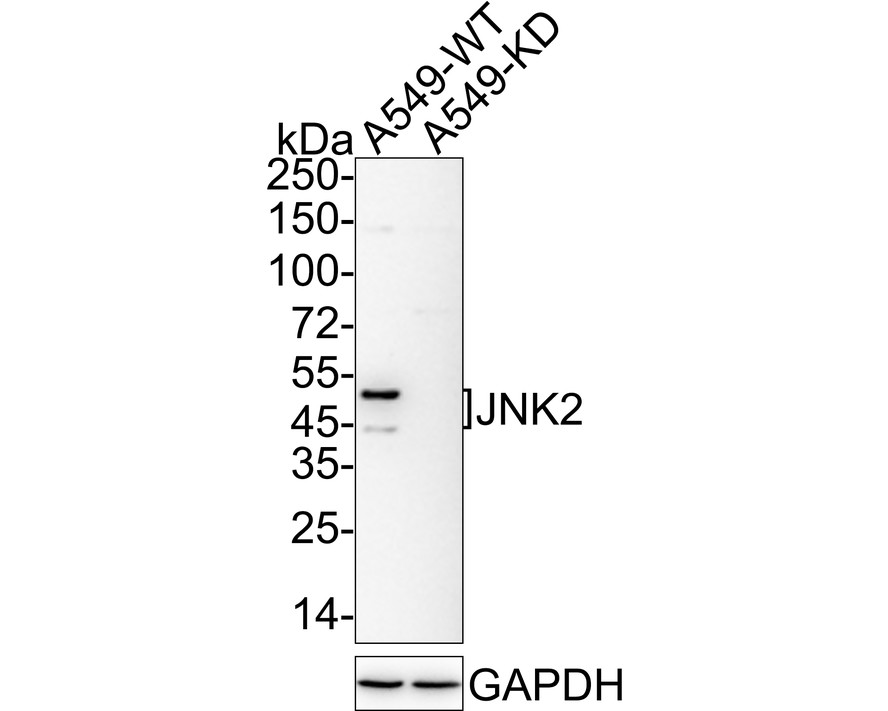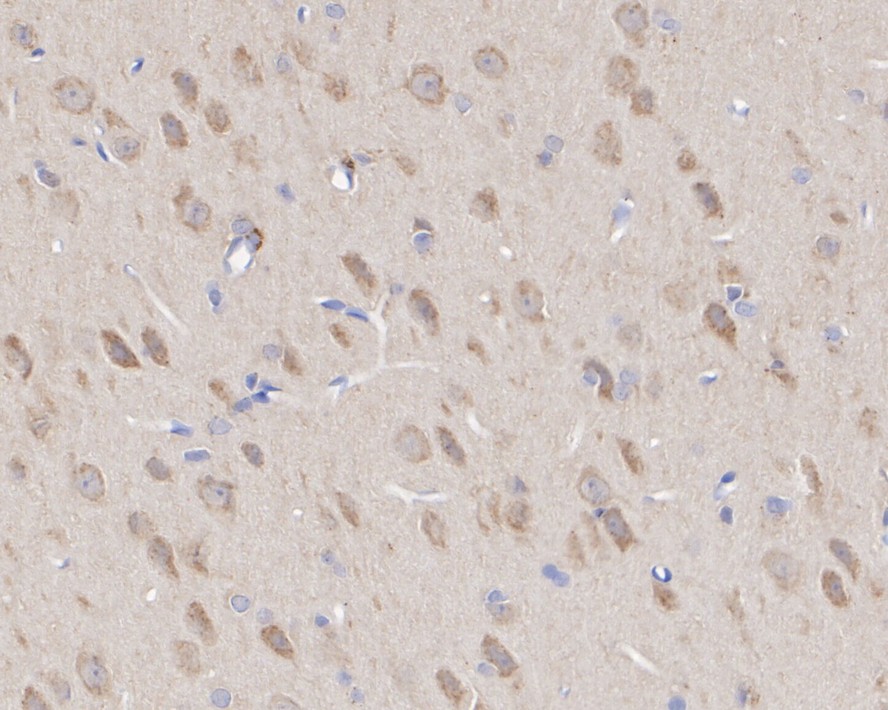JNK2 Recombinant Rabbit Monoclonal Antibody [SC05-85]

cat.: ET1610-11
| Product Type: | Recombinant Rabbit monoclonal IgG, primary antibodies |
|---|---|
| Species reactivity: | Human, Mouse, Rat |
| Applications: | WB, IF-Cell, IHC-P, FC, IP |
| Clonality: | Monoclonal |
| Clone number: | SC05-85 |
| Form: | Liquid |
| Storage condition: | Shipped at 4℃. Store at +4℃ short term (1-2 weeks). It is recommended to aliquot into single-use upon delivery. Store at -20℃ long term. |
| Storage buffer: | 1*TBS (pH7.4), 0.05% BSA, 40% Glycerol. Preservative: 0.05% Sodium Azide. |
| Concentration: | 1ug/ul |
| Purification: | Protein A affinity purified. |
| Molecular weight: | Predicted band size: 48/44 kDa |
| Isotype: | IgG |
| Immunogen: | Synthetic peptide within Human JNK2 aa 341-394 / 424. |
| Positive control: | A549 cell lysate, 293T cell lysate, MCF7 cell lysate, NIH/3T3 cell lysate, C2C12 cell lysate, PC-12 cell lysate, C6 cell lysate, SHG-44 cell lysates, PC-12, NIH/3T3, human brain tissue, mouse brain tissue, rat brain tissue. |
| Subcellular location: | Cytoplasm, Nucleus. |
| Recommended Dilutions:
WB IF-Cell IHC-P FC IP |
1:1,000-1:5,000 1:100 1:1,000 1:1,000 Use at an assay dependent concentration. |
| Uniprot #: | SwissProt: P45984 Human | Q9WTU6 Mouse | P49186 Rat |
| Alternative names: | c Jun kinase 2 C Jun N terminal kinase 2 c-Jun N-terminal kinase 2 JNK 55 JNK-55 JNK2 alpha JNK2 JNK2 beta JNK2A JNK2alpha JNK2B JNK2BETA Jun kinase MAP kinase 9 MAPK 9 Mapk9 Mitogen activated protein kinase 9 Mitogen-activated protein kinase 9 MK09_HUMAN P54a p54aSAPK PRKM9 Protein kinase, mitogen-activated, 9 SAPK alpha SAPK SAPK1a Stress activated protein kinase 1a Stress-activated protein kinase JNK2 |
Images

|
Fig1:
Western blot analysis of JNK2 on different lysates with Rabbit anti-JNK2 antibody (ET1610-11) at 1/2,000 dilution. Lane 1: A549-si NT cell lysate Lane 2: A549-si JNK2 cell lysate Lysates/proteins at 10 µg/Lane. Predicted band size: 48/44 kDa Observed band size: 48/44 kDa Exposure time: 1 minute; ECL: K1801; 4-20% SDS-PAGE gel. Proteins were transferred to a PVDF membrane and blocked with 5% NFDM/TBST for 1 hour at room temperature. The primary antibody (ET1610-11) at 1/2,000 dilution was used in 5% NFDM/TBST at room temperature for 2 hours. Goat Anti-Rabbit IgG - HRP Secondary Antibody (HA1001) at 1/50,000 dilution was used for 1 hour at room temperature. |

|
Fig2:
Western blot analysis of JNK2 on different lysates with Rabbit anti-JNK2 antibody (ET1610-11) at 1/1,000 dilution. Lane 1: 293T cell lysate Lane 2: MCF7 cell lysate Lane 3: NIH/3T3 cell lysate Lane 4: C2C12 cell lysate Lane 5: PC-12 cell lysate Lane 6: C6 cell lysate Lysates/proteins at 20 µg/Lane. Predicted band size: 44/48 kDa Observed band size: 44/48 kDa Exposure time: 25 seconds; 4-20% SDS-PAGE gel. Proteins were transferred to a PVDF membrane and blocked with 5% NFDM/TBST for 1 hour at room temperature. The primary antibody (ET1610-11) at 1/1,000 dilution was used in 5% NFDM/TBST at 4℃ overnight. Goat Anti-Rabbit IgG - HRP Secondary Antibody (HA1001) at 1/50,000 dilution was used for 1 hour at room temperature. |

|
Fig3: Western blot analysis of JNK2 on SHG-44 cell lysates. Proteins were transferred to a PVDF membrane and blocked with 5% BSA in PBS for 1 hour at room temperature. The primary antibody (ET1610-11, 1/500) was used in 5% BSA at room temperature for 2 hours. Goat Anti-Rabbit IgG - HRP Secondary Antibody (HA1001) at 1:5,000 dilution was used for 1 hour at room temperature. |

|
Fig4:
Immunocytochemistry analysis of PC-12 cells labeling JNK2 with Rabbit anti-JNK2 antibody (ET1610-11) at 1/100 dilution. Cells were fixed in 4% paraformaldehyde for 20 minutes at room temperature, permeabilized with 0.1% Triton X-100 in PBS for 5 minutes at room temperature, then blocked with 1% BSA in 10% negative goat serum for 1 hour at room temperature. Cells were then incubated with Rabbit anti-JNK2 antibody (ET1610-11) at 1/100 dilution in 1% BSA in PBST overnight at 4 ℃. Goat Anti-Rabbit IgG H&L (iFluor™ 488, HA1121) was used as the secondary antibody at 1/1,000 dilution. PBS instead of the primary antibody was used as the secondary antibody only control. Nuclear DNA was labelled in blue with DAPI. Beta tubulin (M1305-2, red) was stained at 1/100 dilution overnight at +4℃. Goat Anti-Mouse IgG H&L (iFluor™ 594, HA1126) was used as the secondary antibody at 1/1,000 dilution. |

|
Fig5:
Immunocytochemistry analysis of NIH/3T3 cells labeling JNK2 with Rabbit anti-JNK2 antibody (ET1610-11) at 1/100 dilution. Cells were fixed in 4% paraformaldehyde for 20 minutes at room temperature, permeabilized with 0.1% Triton X-100 in PBS for 5 minutes at room temperature, then blocked with 1% BSA in 10% negative goat serum for 1 hour at room temperature. Cells were then incubated with Rabbit anti-JNK2 antibody (ET1610-11) at 1/100 dilution in 1% BSA in PBST overnight at 4 ℃. Goat Anti-Rabbit IgG H&L (iFluor™ 488, HA1121) was used as the secondary antibody at 1/1,000 dilution. PBS instead of the primary antibody was used as the secondary antibody only control. Nuclear DNA was labelled in blue with DAPI. Beta tubulin (M1305-2, red) was stained at 1/100 dilution overnight at +4℃. Goat Anti-Mouse IgG H&L (iFluor™ 594, HA1126) was used as the secondary antibody at 1/1,000 dilution. |

|
Fig6:
Immunohistochemical analysis of paraffin-embedded human brain tissue with Rabbit anti-JNK2 antibody (ET1610-11) at 1/1,000 dilution. The section was pre-treated using heat mediated antigen retrieval with Tris-EDTA buffer (pH 9.0) for 20 minutes. The tissues were blocked in 1% BSA for 20 minutes at room temperature, washed with ddH2O and PBS, and then probed with the primary antibody (ET1610-11) at 1/1,000 dilution for 1 hour at room temperature. The detection was performed using an HRP conjugated compact polymer system. DAB was used as the chromogen. Tissues were counterstained with hematoxylin and mounted with DPX. |

|
Fig7:
Immunohistochemical analysis of paraffin-embedded mouse brain tissue with Rabbit anti-JNK2 antibody (ET1610-11) at 1/1,000 dilution. The section was pre-treated using heat mediated antigen retrieval with Tris-EDTA buffer (pH 9.0) for 20 minutes. The tissues were blocked in 1% BSA for 20 minutes at room temperature, washed with ddH2O and PBS, and then probed with the primary antibody (ET1610-11) at 1/1,000 dilution for 1 hour at room temperature. The detection was performed using an HRP conjugated compact polymer system. DAB was used as the chromogen. Tissues were counterstained with hematoxylin and mounted with DPX. |

|
Fig8:
Immunohistochemical analysis of paraffin-embedded rat brain tissue with Rabbit anti-JNK2 antibody (ET1610-11) at 1/1,000 dilution. The section was pre-treated using heat mediated antigen retrieval with Tris-EDTA buffer (pH 9.0) for 20 minutes. The tissues were blocked in 1% BSA for 20 minutes at room temperature, washed with ddH2O and PBS, and then probed with the primary antibody (ET1610-11) at 1/1,000 dilution for 1 hour at room temperature. The detection was performed using an HRP conjugated compact polymer system. DAB was used as the chromogen. Tissues were counterstained with hematoxylin and mounted with DPX. |

|
Fig9:
Flow cytometric analysis of NIH/3T3 cells labeling JNK2. Cells were fixed and permeabilized. Then stained with the primary antibody (ET1610-11, 1μg/mL) (red) compared with Rabbit IgG Isotype Control (green). After incubation of the primary antibody at +4℃ for an hour, the cells were stained with a iFluor™ 488 conjugate-Goat anti-Rabbit IgG Secondary antibody (HA1121) at 1/1,000 dilution for 30 minutes at +4℃. Unlabelled sample was used as a control (cells without incubation with primary antibody; black). |
Note: All products are “FOR RESEARCH USE ONLY AND ARE NOT INTENDED FOR DIAGNOSTIC OR THERAPEUTIC USE”.